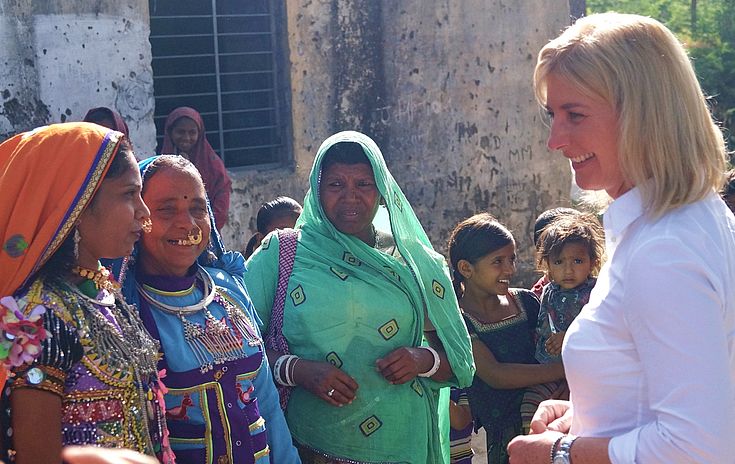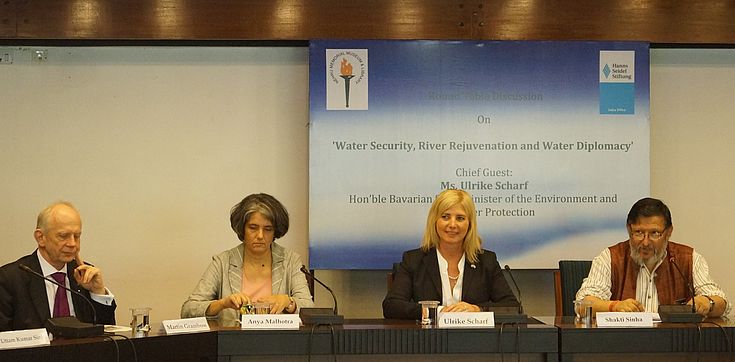News
Visit of the Hon’ble Bavarian State Minister to India on 24-29 March 2017
Minister Scharf interacting with the villagers
There exists precarious water situation in Rajasthan. The ground water levels in 190 of the 236 blocks are either overused or critically short of water declaring them as 'dark zones'. About 13,500 villages do not have access to safe drinking water, surviving solely on water tankers. Only 10% of the wells have safe drinking water.
In Abu Road in Umarni village, the Minister saw the water management sites and structures and interacted with the villagers to know more about the water issues in the area. Umarni is one of the villages where HSS through its partner organisation Centre for Social Research has intervened to bring about attitudinal changes in and orient the Panchayati Raj Institutions towards tackling water challenges locally and contributing towards the global efforts to deal with the water challenges.
On the way to Ahmedabad from Abu Road on 27 March, the Minister also had a stopover at the Adalaj Stepwell, built in 1499, to provide water to the local communities. These type of stepwells are the reminders of the fact that ensuring easy access by bringing sources of water close to the communities has been a significant aspect of governance.
After the Adalaj visit, the Minister participated in the round-table organised by the Centre for Environment Education (CEE) Ahmedabad in its campus where the Minister was briefed about the HSS-CEE water and climate project in the Indian State of Gujarat and there occurred a cross-exchange of ideas as to how to manage water and tackle the Climate Change in a better way.
Minister Scharf participating in the Round Table at NMML
In the Indian state of Gujarat, the major source of water is surface water which is very prone to Climate Change. As per one estimate, the total available quota of water is 55,608 million cubic meters, nearly 68.51% of which is surface water. In the Saurastra region of Gujarat, where HSS has been intervening with its project partner CEE, the situation is worse. There, water is scarce and saline. With its geographical area of 31%, Saurastra has only 9% of water.
In Delhi on 28 March, the Minister paid a visit to the Union Ministry of Environment, Forest and Climate Change to cross-exchange the ideas with regard to the environment protection and making joint effort in Climate Change adaptation and mitigation.
The Bavarian State Minister Ms Scharf also called upon the Union Minister Ms Uma Bharati of Ministry of Water Resources, River Development and Ganga Rejuvenation. Both the Ministers shared the global concerns on the looming water crises and climate change and explored probable area of cooperation in water resources sector, especially in the ongoing Government of India’s mission to clean up and rejuvenate Ganga river.
Ganga river rises in Himalayas and traverse a course of more than 2500 km before it flows into the Bay of Bengal. In addition to its cultural and spiritual significance, the Ganga basin accounts for 30% of India’s water resources and affects the lives of more than 40% of India’s total population. Today, large part of Ganga river course stands polluted due to organic and industrial waste, sewage, human dead bodies, animal carcasses etc. In Ganga Basin, approximately 12,000 million litres per day (mld) sewage is generated. The standing treatment capacity is of only around 4,000 mld.
Understanding the severity of problems, during the meeting, both the Ministers agreed to work out some mechanism to help clean up and rejuvenate the Ganga river. Both the Minister also agreed to form a joint group to identify areas of co-operation in water sector and study best practices of water and river management in Germany to replicate/adapt them in the Indian context.
As the population grows and urbanisation further scales up, the pressure on water will increase. Many regions in the world are already facing the phenomenon called ‘water-stress’. The advent of Climate Change has added a new set of challenges to the existing water problems. The Climate Change is likely to affect the hydrological cycle which may lead to erratic rainfalls, increase in temperature and high evapotranspiration. This will increase the instances and duration of droughts, posing serious challenges to the population, which may lead to large scale migration and loss of lives.
Speaking at the round-table discussion organised by the Hanns Seidel Stiftung (HSS) at the Nehru Memorial Museum & Library (NMML) New Delhi on 28 March, the Bavarian State Minister of Environment & Consumer Protection, Ms Ulrike Scharf, informed the audience that even in Germany now you see the instances of droughts and in spite of having a robust system of water management, the country still faces water issues.
Water is a finite resource, albeit renewable. It is unevenly distributed across the globe in terms of supply and demand. The scarcity of water globally turns water into a political good. There is emerging consensus for distribution of water on the principle of equity: ensuring water for all. The linkage of water with life, livelihood and livestock brings water at the centre-stage of the contemporary political debate, policy formulation and action.


